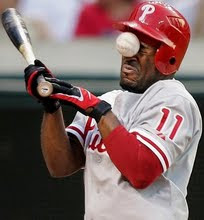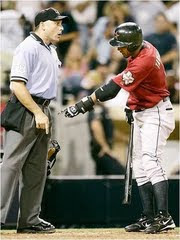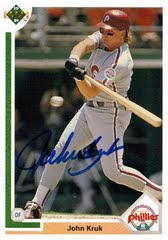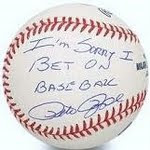Haren went to Arizona from the A's only two and a half seasons ago for a haul of prospects that included Carlos Gonzalez, Chris Carter and Brett Anderson. Considering how good Haren is (career 3.61 xFIP, 3.38 xFIP this season) and how much the Diamondbacks paid for him, it is surprising to see how little they wanted in return, even if they were trying to dump salary. It is hard to imagine that this was all that the Diamondbacks could get in return when the Yankees (Jesus Montero), Twins (Wilson Ramos) and Mets (Wilmer Flores, Jennry Mejia, Fernando Martinez) were all on the market for a quality arm.
Readers of my Game of Inches blog should all know how much I love Haren. I have detailed just how good he is many times, defended his honor on ESPN podcasts, and despite his early season struggles and career second half struggles, Haren remains a top 10 rest of season starting pitcher in my estimation
On average, pitchers generally surrender home runs on 11 percent of flyballs (note: using OF_FB% instead of FB% has no statistically significant impact on xFIP). Per The Hardball Times' top secret four-year park factor data, Arizona inflates HR/FB% for pitchers. However, Haren has not played all his game at home: he's pitched 66.2 of his 141 innings on the road (52.7 percent of his innings have come at home). Hence, the true park factor index of Chase Field on Haren's starts is only 1.058. This pushes Haren's adjusted park factor HR/FB rate to 11.64 percent. His current rate is well above that, at 13.9 percent.
To translate Haren's ERA, we cannot simply take his xFIP and run with it. As Derek Carty has previously pointed out, a change in leagues has a noticeable effect on a pitcher's K/9, BB/9 and HR/FB percentage thanks to that designated hitter guy (versus the pitcher). Thus, we need to first translate the peripherals and get a zFIP (alternative expected FIP).
As Haren has 607 batters faced, most of his peripheral rates are statistically significant. Hence we can use his current strikeout and walk rates as a baseline. At the moment, Haren has a 9.00 K/9 and 1.85 BB/9 (4.86 K/BB). As noted above, his expected HR/FB% this season is ~11.64 percent. To account for Haren's change in leagues, we need to (1) subtract 0.57 from his current K/9) add 0.05 to his current groundball rate, and 3) 0.21 percent to his adjusted HR/FB rate. Over the course of 141 IP and 165 flyballs surrendered, these numbers extrapolate into 132 strikeouts, 30 walks and 19.5 home runs.
Keeping Haren's HBP/IBB totals constant and using The Hardball Times adjusted FIP formula of 3.2+((HR*13+(BB+HBP-IBB)*3-K*2))/IP), we get a zFIP of 3.74 for AL Dan Haren. Using this 3.74 mark as the baseline for our ERA projection, we need to get an expected innings total and account for park factors and defense.
The Angels only have 62 games remaining. Assuming that Haren slides right into his rightful role as team ace, this puts him at around 12 more starts on the regular season. Haren is averaging six and two-thirds innings per start, which would put his innings load max around 80. For the sake of getting a nice number, let's pretend the Angels, who are seven games out of first place, make a playoff run this season (though I think Haren is more of a 2011/12 acquisition) and allow Haren to reach this max load. At a league-adjusted K/9 of 8.43 and zFIP of 3.74, this would give Haren 75 strikeouts and 33.25 runs allowed.
Now that we have an innings projection, we need to accord for park factors and team defense. Per Baseball-Reference, Angel Stadium inflates run scoring by 2 percent. Since a player generally plays just half his games at home, we should use a 1 percent park factor. Multiplying Haren's runs total by a 1.01 park index, we get a new RA total of 33.58.
Though park factors will likely not have much of an impact on Haren's expected RA total, the Angels' defense, which includes Bobby Abreu, might. In 883.2 innings of defense, the Angels have allowed 26.2 more runs to score than the league average defense. (The Angels have the fourth lowest UZR/150 in baseball). This gives the Angels a UZR/inning of -0.02966. Over 80 innings pitched, that means that the Angels defense will allow 2.37 more runs to score than would the league average defense. Adding this to Haren's park factor adjusted RA total, we get a final RA total of 35.95.
Over 80 IP, the above indicates that Haren has an expected ERA of 3.82. That is well below the Angels' current team ERA/xFIP of 4.40/4.37.
 But what about Haren's WHIP? Thanks to Tom Tango's research and a day of macro programming, I created an xWHIP calculator a few weeks ago to answer that very question. Plugging in the relevant numbers, we see that Haren's current WHIP of 1.35 translates into a xWHIP of 1.07 with a hits per nine rate of 8.2 (yet another sign of Haren's awful luck in 2010).
But what about Haren's WHIP? Thanks to Tom Tango's research and a day of macro programming, I created an xWHIP calculator a few weeks ago to answer that very question. Plugging in the relevant numbers, we see that Haren's current WHIP of 1.35 translates into a xWHIP of 1.07 with a hits per nine rate of 8.2 (yet another sign of Haren's awful luck in 2010).As noted above, a change in leagues generally results in a +0.05 increase in a pitcher's BB/9 and Angel Stadium has a 0.99 walk rate index compared to Chase Field. This yields an xBB total for Haren the Angel of 16.7 per 80 IP.
Similarly, Angel Stadium has a 0.99 hits rate index compared to Chase Field of .90. This yields an xHits total of 65.6 for Haren on his new team, at least before defense is considered. However, as noted above, the Angels have a UZR/INN of -0.02966. Tom Tango has previously broken down runs-expectancy based on types of hits and has found that the average single is worth approximately 0.49 runs. Assuming that all additional hits allowed by the Angels' defense would be singles, the Angels' defense would yield an additional 4.8 hits. Adding this to his expected hits total, we find that Dan Haren as an Angel has an xHit total of 70.4 per 80 IP.
The above analysis yields an xWHIP of 1.09 for Dan Haren in Anaheim. Through today, the Angels have a team WHIP of 1.40. Hence Haren is a noticeable improvement for the Angels in the baserunner prevention department (which is somewhat important given the state of the Angels' defense).
Fantasy spin: All in all, my analysis shows that Haren has the following expected pitching line as an Angel: 80 IP, 3.82 ERA, 1.09 WHIP, 75 K, 4.5 K/BB. Those numbers are not quite as ERA/WHIP pretty as Cliff Lee's projected numbers (though much of it has to do with the Angels' poor defense), but his plus-quality ERA/WHIP and high strikeout ability make Haren a tantalizing must-own AL option for the rest of the season. If you have FAAB, empty it accordingly.
Real life spin: One can easily see how Haren can improve the Angels' current 4.40 team ERA/1.40 team WHIP. What one cannot see, however, is how the Diamondbacks benefit from this trade. Bryan Smith of Fangraphs analyzed what the Diamondbacks netted in return for Haren and somewhat rationalized the deal. However, given Haren's talent, the market for a quality arm (of which Haren was the best and cheapest available option), and what the Diamondbacks paid for Haren in the first place, this trade makes very little sense to me.







1 comments:
my phone just hung up on you again
Post a Comment